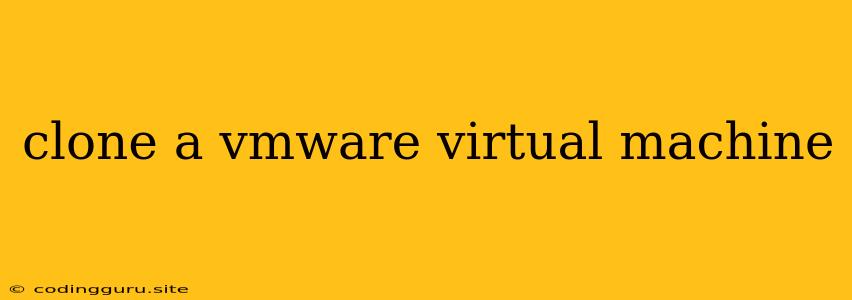Cloning a VMware Virtual Machine: A Comprehensive Guide
Creating a copy of a VMware virtual machine can be a valuable practice for various purposes, including:
- Testing and Development: Cloning allows you to experiment with different configurations or software updates without affecting the original VM.
- Disaster Recovery: Having a cloned VM readily available can act as a backup in case of hardware failure or data loss.
- Deployment: Cloning a VM streamlines the process of deploying multiple instances of the same application or operating system.
This guide will walk you through the process of cloning a VMware virtual machine, covering different methods and essential steps.
Why Clone a VM?
There are numerous reasons why you might want to clone a VMware virtual machine. Here are a few common scenarios:
- Testing New Software or Updates: Before implementing any new software or updates on your production VM, it's wise to test them on a clone first. This ensures that the changes don't disrupt your live environment.
- Creating a Staging Environment: Having a clone of your production VM serves as a dedicated staging environment for testing configurations, code deployments, or software updates.
- Disaster Recovery: A clone of your VM acts as a backup, allowing you to quickly restore your system in case of a hardware failure or data corruption.
- Quick Deployment: Instead of manually configuring multiple virtual machines from scratch, you can simply clone an existing VM and customize it to meet your specific needs.
Cloning Methods
There are several ways to clone a VMware virtual machine, each with its own advantages and considerations:
- Using the vSphere Web Client (or vCenter Server):
- This is the most common and straightforward method.
- Navigate to the VM's settings, select "Clone," and follow the wizard to configure the clone.
- Using the vSphere Command Line Interface (vSphere CLI):
- Offers more control and flexibility.
- Requires familiarity with command-line tools.
- Using the VMware vCenter Orchestrator:
- Automation-focused approach.
- Ideal for large-scale deployments or complex cloning scenarios.
Steps to Clone a VM Using the vSphere Web Client:
- Open the vSphere Web Client: Access the vSphere Web Client and log in with your credentials.
- Locate the VM to Clone: Navigate to the virtual machine you want to clone.
- Access VM Settings: Right-click on the VM and select "Clone."
- Choose a Clone Method: Choose "Linked Clone" or "Full Clone" depending on your requirements:
- Linked Clone: A faster option that shares the disk space with the original VM, making it ideal for testing and development.
- Full Clone: Creates a complete independent copy of the VM, useful for disaster recovery or deployment.
- Configure the Clone: Select a name and location for your cloned VM. Configure the storage and network settings as required.
- Start the Clone Process: Review your settings and click "Finish" to initiate the clone process.
- Monitor the Progress: You can monitor the progress of the cloning process in the vSphere Web Client.
Tips for Cloning a VM:
- Optimize Storage: Ensure your storage has enough space to accommodate the cloned VM, especially for full clones.
- Customize Network Settings: Adjust the network settings of the cloned VM to match your desired configuration.
- Modify VM Resources: If necessary, adjust the CPU, RAM, and other resources allocated to the cloned VM.
- Rename and Tag the Clone: Clearly label the cloned VM for easy identification and organization.
- Testing and Validation: After cloning, thoroughly test the cloned VM to ensure it functions correctly.
Potential Challenges and Solutions:
- Storage Space: Insufficient storage space can hinder the cloning process. Ensure you have enough available storage for the cloned VM.
- Network Connectivity: Network issues can prevent the cloned VM from accessing resources. Verify network settings and troubleshoot any connectivity problems.
- Configuration Conflicts: If the original VM has specific configurations or dependencies, cloning may result in conflicts. Review and adjust settings as needed.
Troubleshooting Cloning Errors:
- "Insufficient Storage" Error: This error indicates that the available storage is insufficient for the clone. Free up disk space or select a different storage location.
- "Failed to Connect to ESXi Host" Error: Verify your network connection to the ESXi host and check for any network issues.
- "General Cloning Error": This error could be caused by various factors, including configuration issues or resource constraints. Refer to VMware documentation for detailed troubleshooting steps.
Conclusion:
Cloning a VMware virtual machine offers a versatile solution for various tasks, including testing, disaster recovery, and deployment. By understanding the different cloning methods and following the steps outlined above, you can successfully create copies of your VMs for various purposes. Remember to thoroughly test your cloned VMs after the process to ensure their functionality and address any potential issues.
